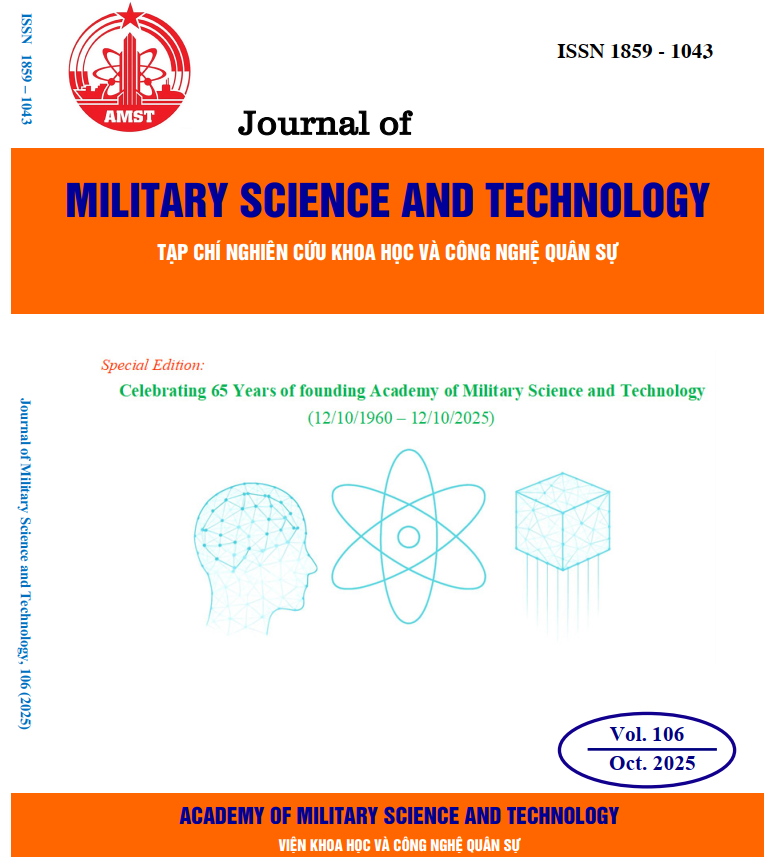Nghiên cứu phân tích một số thành phần chính của chất khử trùng MDF-500 do Hoa Kỳ sản xuất
192 lượt xemDOI:
https://doi.org/10.54939/1859-1043.j.mst.106.2025.63-71Từ khóa:
MDF-500; Khử trùng; Hydrogen peroxide.Tóm tắt
Nhu cầu chất khử trùng đã tăng lên theo cấp số nhân trên toàn cầu sau đại dịch COVID-19 nhằm phòng ngừa, kiểm soát nguy cơ tiếp xúc với vi sinh vật độc hại cho người, môi trường và hạ tầng. Các bề mặt bị ô nhiễm là nơi vi sinh vật có thể tồn tại và sống sót trong nhiều ngày. Chất khử trùng MDF-500 đã được Cơ quan bảo vệ môi trường (EPA) khuyến cáo sử dụng. MDF-500 có phổ hoạt tính kháng khuẩn rộng đối với tác nhân hóa học và sinh học. Mặc dù được sử dụng rộng rãi nhưng thông tin về thành phần của MDF-500 còn rất hạn chế. Do đó, việc nghiên cứu phân tích xác định thành phần chính của MDF-500 bằng các kỹ thuật định tính và định lượng, làm cơ sở cải tiến, nâng cấp tính năng kỹ thuật là cần thiết. Các thành phần chính được xác định bao gồm hydrogen peroxide (H2O2), natri hypochloride (NaOCl), benzalkonium chloride, cetyltrimethylammonium bromide và cetylpyridinium chloride. Kết quả phân tích cho thấy MDF-500 gồm H2O2 1,25%, NaOCl 9,47% và có pH = 10,74.
Tài liệu tham khảo
[1]. Epelle, E. I., Macfarlane, A., Cusack, M., Burns, A., Okolie, J. A., Vichare, P., Rolland, L., & Yaseen, M. "Ozone decontamination of medical and nonmedical devices: an assessment of design and implementation considerations." Industrial & Engineering Chemistry Research, 62, 4191–4209, (2023). DOI: https://doi.org/10.1021/acs.iecr.2c03754
[2]. Dhama, K., Patel, S. K., Kumar, R., Masand, R., Rana, J., Yatoo, M. I., Tiwari, R., Sharun, K., Mohapatra, R. K., & Natesan, S. "The role of disinfectants and sanitizers during COVID-19 pandemic: advantages and deleterious effects on humans and the environment." Environmental Science and Pollution Research, 28, 34211–34228, (2021). DOI: https://doi.org/10.1007/s11356-021-14429-w
[3]. Sahu, R., Sahoo, R. K., Prusty, S. K., & Sahu, P. K. "Urinary tract infection and its management." Systematic Reviews in Pharmacy, 10, 42–48, (2019). DOI: https://doi.org/10.5530/srp.2019.1.7
[4]. Fink, K., Örgel, M., Baier, C., Brauckmann, V., Giannoudis, V., & Liodakis, E. "Quality of lower limb preoperative skin preparation using colorless versus colored disinfectants – results of an experimental, randomized study in a close to reality setting." PLoS One, 18, e0282662, (2023). DOI: https://doi.org/10.1371/journal.pone.0282662
[5]. Tadros, M. E., & Tucker, M. D. Formulations for neutralization of chemical and biological toxants. Sandia National Laboratories, Livermore, CA, USA, (2003).
[6]. Tucker, M. D., & Engler, D. E. Decontamination formulations for disinfection and sterilization. Google Patents, (2007).
[7]. USP-NF. "United States Pharmacopeia." United States Pharmacopeia, (2024).
[8]. "Xác định nhiệt độ sôi và khoảng chưng cất." Vietnamese Pharmacopoeia (in Vietnamese).
[9]. "TCVN 3731:2007 (ISO 758:1976) về sản phẩm hóa học dạng lỏng sử dụng trong công nghiệp – xác định khối lượng riêng ở 20 °C." (in Vietnamese).
[10]. "TCVN 6185:2015 (ISO 7887:2011) về Chất lượng nước – Kiểm tra và xác định độ màu." (in Vietnamese).
[11]. Auerbach, M. E., & Browning, R. S. “Test composition for determining the concentration of quaternary ammonium compounds in aqueous solution”. Google Patents, (1961).
[12]. Lin, H., Zhu, H., Guo, J., & Wang, N. "Interactions between bromophenol blue and cetyl-trimethylammonium bromide in aqueous solutions and microemulsions." Journal of Dispersion Science and Technology, 38, 1410–1414, (2017). DOI: https://doi.org/10.1080/01932691.2016.1250215
[13]. Sobika, M., Karunanithi, S., & Dash, S. "Studies on anionic dye Eosin Y in mixed anionic micellar medium." Results in Chemistry, 7, 101220, (2024). DOI: https://doi.org/10.1016/j.rechem.2023.101220
[14]. Yoo, M. J., & Park, H. B. "Effect of hydrogen peroxide on properties of graphene oxide in Hummers method." Carbon, 141, 515–522, (2019). DOI: https://doi.org/10.1016/j.carbon.2018.10.009
[15]. Trautmann, E., Attin, T., Mohn, D., & Zehnder, M. "Hydrogen peroxide versus sodium hypochlorite: all a matter of pH?" Journal of Endodontics, 47, 297–302, (2021). DOI: https://doi.org/10.1016/j.joen.2020.10.016
[16]. Artasensi, A., Mazzotta, S., & Fumagalli, L. "Back to basics: choosing the appropriate surface disinfectant." Antibiotics, 10, 613, (2021). DOI: https://doi.org/10.3390/antibiotics10060613
[17]. McFadden, J., Holloway, D., Whittle, E., & Basketter, D. "Benzalkonium chloride neutralizes the irritant effect of sodium dodecyl sulfate." Contact Dermatitis, 43, 264–266, (2000). DOI: https://doi.org/10.1034/j.1600-0536.2000.043005264.x
[18]. Burel, C., Direur, G., Rivas, C., & Purevdorj‐Gage, L. "Colorimetric detection of residual quaternary ammonium compounds on dry surfaces and prediction of antimicrobial activity using bromophenol blue." Letters in Applied Microbiology, 72, 358–365, (2021). DOI: https://doi.org/10.1111/lam.13429
[19]. Zheng, J., Ma, Z., Zhang, Q., Qiu, L., Wang, Z., & Wang, N. "Effect of CTAB premicelle and micelle formation on Bromophenol Blue spectra." ChemistrySelect, 9, e202400090, (2024). DOI: https://doi.org/10.1002/slct.202400090
[20]. Colichman, E. L. "Spectral study of long chain quaternary ammonium salts in brom phenol blue solutions." Journal of the American Chemical Society, 73, 3385–3388, (1951). DOI: https://doi.org/10.1021/ja01151a113
[21]. Erdinc, N., & Göktürk, S. "Spectrophotometric and conductometric studies on the interaction of anionic dye eosin-y with cationic micelles." Analytical Chemistry Letters, 4, 146–157, (2014). DOI: https://doi.org/10.1080/22297928.2014.960534
[22]. Yadav, C. K., Adhikari, M. K., Maharjan, J., & Bhattarai, A. "An analysis of cetylpyridinium chloride (CPC) by FESEM, EDX methods, and its applications." Rajarshi Janak University Research Journal, 2, 1–7, (2024). DOI: https://doi.org/10.3126/rjurj.v2i1-2.72263
[23]. Yadav, C. K., Niraula, T. P., Neupane, S., Yadav, A. P., & Bhattarai, A. "Study of anti-corrosion properties of sodium dodecyl sulphate and cetyl pyridinium chloride." Journal of Nepal Chemical Society, 44, 163–172, (2024). DOI: https://doi.org/10.3126/jncs.v44i1.62690
[24]. "MDF-500 Part A EPA Registered disinfectant." Source: https://thermacote.com/wp-content/uploads/SDS-MDF-500-Part-A-3.20.pdf; "MDF-500 Part B EPA Registered disinfectant." Source: https://thermacote.com/wp-content/uploads/SDS-MDF-500-part-B-3.20.pdf; "MDF-500: Industrial-Grade Disinfectant." Source: https://thermacote.com/mdf500-industrial-disinfectant/, (2020).
[25]. Haque, A. "An exclusive handbook of flexible packaging materials: equipped with raw materials, manufacturing & quality machinery & procedures, case studies and troubleshooting’s." (2024). DOI: https://doi.org/10.2139/ssrn.4873582







